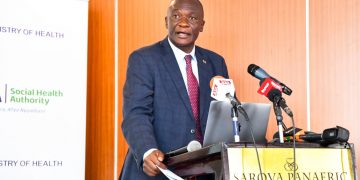Health experts have called for concerted efforts to fight pneumonia which is the world’s leading infectious disease killer of children aged five years and below.
The experts say globally, a child dies of pneumonia every 43 seconds, which translates to an estimated 800,000 deaths every year which includes 200,000 newborns.
Speaking during a media briefing held recently in Nairobi, the Director-General of Health, Dr Patrick Amoth observed: “Although pneumonia is the leading killer of children after the neonatal period in Kenya, it remains under prioritised in terms of visibility, financial investments and research funding,”.
Dr Amoth made the remarks ahead of the commemoration of the World Pneumonia day which was locally held in Siaya county on November 12.
The theme for this year’s day is “Defeat Pneumonia:”Every breathe counts; every action matters”.
The observance was introduced to raise public awareness towards pneumonia—a disease that still continues to affect the most vulnerable population who are children below five years.
According to Unicef data, in 2019, Kenya had 14 per cent of deaths caused by pneumonia in children under five years of age and was ranked 28th pneumonia contributor in the sub-Saharan region.
“Deaths due to childhood pneumonia are strongly linked to poverty-related factors such as under-nutrition, lack of safe drinking water and sanitation, indoor and outdoor air pollution as well as inadequate access to health care, almost all these deaths are preventable,” the report adds.
In Kenya, Dr Amoth—in a speech read by Dr Stephen Muleshe– said every breath lost to pneumonia is a call to action because behind each statistic is a child whose life could be saved with timely care.
“Despite this fact, Kenya has made remarkable progress in reducing under five mortality rates from 74/1,000 live births a few years back, to the current 41/1,000 live births in 2022.
“This has been largely due to national policies that create an environment at both national and county levels that prioritise interventions that mitigate top causes of childhood morbidity and mortality,”.
At the same time, Dr Amoth identified diarrhoea and pneumonia as the top causes of ill health in children and neonatal morbidity accounts for almost half of all under five mortalities.
The Director-General observed: “To reduce mortality among children who develop pneumonia, we must enhance care-seeking behaviour within communities and expand access to timely, accurate, and affordable diagnosis and treatment across all levels of the health system.
“This includes strengthening the availability and use of pulse oximetry, medical oxygen, medicines and medical supplies and other essential respiratory support technologies, which remain limited in many healthcare settings,”.
This year’s theme, Dr Amoth noted, aligns well with the renewed Ministry of Health efforts and commitments to reduce childhood deaths from pneumonia, emphasising the need to accelerate the scale-up of prevention, diagnosis, and treatment interventions.
“As a result, the Ministry has introduced and scaled up interventions that have a long-term impact on mitigating these causes in line with the frameworks of pneumonia interventions ‘Protect, prevent and treat’.
Some of these interventions include availability of vaccines against pneumonia, integrated community case management, access of Amoxicillin DT, integrated management of newborn and childhood illnesses and continuity of care for children with pneumonia.
Dr Amoth noted: “I therefore urge our development partners to support these integrated strategies and innovations.
“This will go a long way in helping us as country to achieve our set targets in reducing childhood deaths,”.













